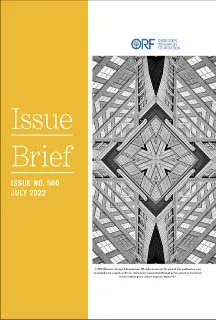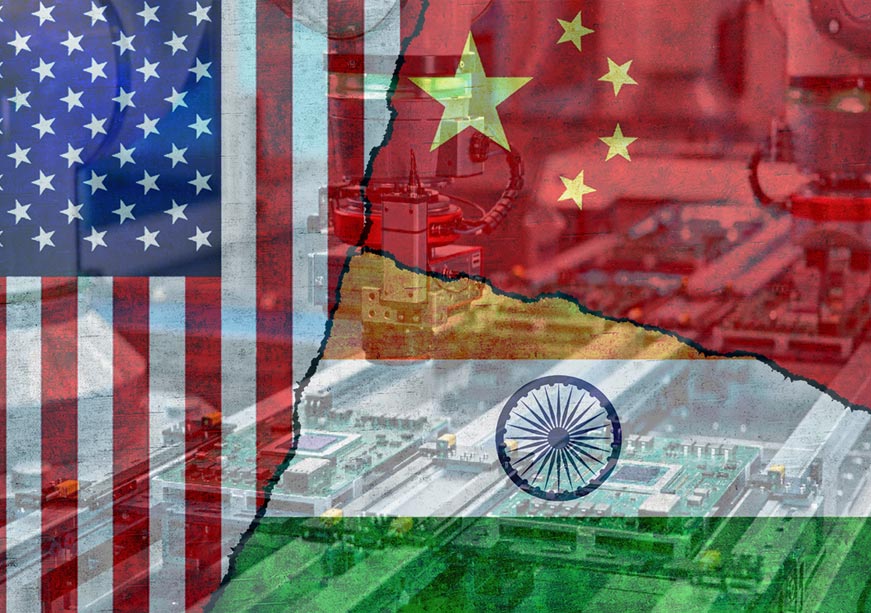Introduction
China’s lack of transparency both in its nuclear arsenal and overall nuclear doctrine has been a cause for concern in many parts of the world.[1] This is not to say that other nuclear-armed states have been transparent about their arsenals; most of them, such as Russia[2] and the United States,[3] are equally reticent in making public certain data and information that they consider classified. Today, however, the anxiety around China’s nuclear stockpiles and its future plans for modernisation is exacerbated by the growing concerns over rising nuclear aggression by and amongst nuclear weapons states and what it means for the current world order. For example, North Korea launched nine ballistic missiles in January 2022—the highest number of tests in the country’s history.[4]
Current estimates say—based on data collated and analysed by experts in the US—that China has approximately 350 nuclear warheads ready for delivery.[5] These warheads are ready for delivery through approximately 280 land-based and 72 sea-based ballistic missiles. Additionally, China is estimated to have 20 nuclear gravity bombs assigned to bombers.[6],[7]
It would appear that China is veering away from its policy of maintaining a minimal nuclear deterrent,[8] provoking concerns especially among those countries with which it has rivalries. Observers in the US have postulated that China is constructing over 200 new missile silos in the mainland, which could bring its total silo-based intercontinental ballistic missiles (ICBM) count far higher than the 20 it has maintained over the last couple of decades.[9] China is also expanding its arsenal with more road-based ICBMs as well as strategic nuclear submarines.[10] The US Department of Defense estimates that China’s nuclear warhead numbers may be as high as 700, ready for delivery by 2027, and potentially 1,000 warheads by 2030.[11]
The rest of this brief will map out a history of China’s nuclear weapons programme, quantify its nuclear arsenal and describe its modernisation plans (to the extent possible, given the paucity of credible data), and ponder the implications for India and the global nuclear order.
China’s Nuclear Programme: Brief History
China’s founding leader, Mao Zedong, famously believed that it is conventional weapons, and not nuclear, that would play a pivotal role in case of a war.[12] In the 1950s, when China’s nuclear programme began, the quest was for developing nuclear energy for peaceful uses. As China worked on modernising the People’s Liberation Army (PLA) beginning in 1955, then-leader Deng Xiaoping evolved the scientific base of China which was key in what would ultimately be the country’s nuclearisation by 1964.[13]
The shift towards building a nuclear weapons arsenal would take place quickly around that time as a result of the United States’s (US) policy decisions to deter China’s involvement in the Korean War. Several key political leaders in China argued for the need to “master atomic energy.”[14] This led to the development of China’s nuclear programme, which was solidified with help from the 1953 technology transfer agreements it signed with the Soviet Union.[15] Indeed, Soviet assistance in the early 1960s was essential to China’s build-up of its nuclear capabilities; the Soviet Union provided military and technical assistance, as well as an experimental nuclear reactor and uranium-processing units.[16] China viewed the acquisition of nuclear weapons as the only viable avenue for greater military supremacy in a bipolar world governed by the hegemons at the time, the United States and the Soviet Union. Concerns were voiced within China’s PLA over potential threats from the US and the Soviet Union, and they considered nuclear weapons as key to a stronger defence strategy.[17]
China’s nuclear relationship with the Soviet Union, however, was short-lived. The two closed their agreements amidst various strains, including the ideological differences between the Mao Zedong and Nikita Khrushchev leaderships as seen in the former’s opposition to Soviet relations with the US and Britain.[18] Dissatisfaction in China also grew over the inefficiency of technical and economic aid from the Soviet Union. In March 1969, China’s forces ambushed Soviet soldiers on the Zhenbao Island on the Ussuri river, compounding the tensions. China viewed the Ussuri river attack as a deterrence measure against any future Soviet aggressions, whereas the Soviets regarded it as “aggressive and emblematic of an increasingly revisionist and antagonistic regime in Beijing.”[19]
Even as the nuclear relationship between China and the Soviet Union ended, China remained committed to the development of its nuclear weapons programme. It held its first successful nuclear test on 16 October 1964 at its Lop Nur test site, detonating a Uranium-235 fission device.[20] China then marked itself as the fifth nuclear weapons state in the world. It would conduct more tests in the subsequent years, and by 1996, it had conducted 45.[21]
China’s final nuclear tests in 1996 were aimed at the miniaturisation of nuclear warheads—an advancement in its nuclear weapons programme. China has also focused on the development of its sea-based nuclear forces as well as considered developing tactical nuclear weapons.[22] In 2000, the US National Security Council reported to Congress that China possessed some 150-160 nuclear warheads, with around 60 to 70 nuclear armed ballistic missiles.[23] Some years later, in 2005, the US Department of Defense reported that China had 250-296 launchers with around 105 nuclear warheads.[24] An article in Bulletin of the Atomic Scientists at around the same time pegged the number at 200 warheads, with 130 ready for delivery.[25] To be sure, none of these estimates of China’s nuclear stockpile over the years have been confirmed by the Chinese government.
Current Strength
Land-based missile force
China has heavily invested in its land-based ballistic missiles and their systems and possesses one of the world’s largest missile forces. According to one estimate, China’s PLA Rocket Force has 280 land-based missiles capable of nuclear warhead delivery. China currently has around 40 missile brigades.[26] Most of its ballistic missiles are of medium or intermediate range and have around 60 nuclear warheads assigned to them. As China expands its land-based missile force, it is modernising its nuclear force as well. In the case of ICBMs, China has moved to “transition from older, transportable, liquid-fuel, slow-launching missiles to longer-range, road-mobile, solid-fuel, quicker- launching missiles.”[27]
China’s short-range ballistic missiles for land-based delivery are mostly conventional, with the exception of one as a result of a nuclear test it conducted which was potentially related to short-range ballistic missile development.[28] China’s land-based missiles fielding nuclear weapons include the DF-4 ICBM, DF-5A ICBM, DF-21A/E medium range, DF-26, DF-31 ICBM, DF-31A ICBM, DF-31AG ICBM, and DF-41 ICBM. Notably, the DF-41 is capable of carrying multiple independently targetable re-entry vehicles (MIRV).[29] In 2021, China ramped up construction of several hundred ballistic missile silos across the country.[30]
Sea-based force
The PLA Navy operates five of its six Type 094 nuclear-powered ballistic missile submarines (SSBN).[31] There are two of the new variant (Type 094A) brought into the navy in April 2020. These submarines can potentially carry from 12 to 16 submarine-launched ballistic missiles. A larger and heavier Type 096 is also in the works.[32] China’s fleet can potentially carry the 7,200-km-range JL-2 submarine-launched ballistic missile (SLBM) and the new variant of the SSBN which gives it a more robust second-strike ability. Military analysts speculate that the newer JL-3 SLBM has a potential range of 9,000 km, which the Type 096 SSBNs are capable of carrying.[33]
Bombers and cruise missiles
The PLA Air Force nuclear mission with regard to its bomber was largely inactive until the early 2000s, although its aircrafts were used in over 10 of its nuclear tests to deliver nuclear bombs.[34] Despite the overall inactivity, China has maintained its bomber delivery capabilities, and its air force is developing nuclear-capable air-launched ballistic missile (ALBM). According to the US Department of Defense, China’s H-6 bomber and a potential future stealth bomber are both nuclear-capable.[35] The future H-20 bomber, which is set to replace the H-6 bomber, will begin production as well. China has also reassigned nuclear missions to its bombers.[36]
A few years ago, in 2017, the US Air Force were of the view that the Chinese CJ-20 air-launched land attack cruise missile or the DH-10 (now called the DF-10) ground-launched cruise missile have nuclear or dual-use capabilities.[37] However, US Air Force Global Strike designated them as “conventional”.[38] The US claims that China has both air-launched and sea-launched nuclear cruise missiles, but it remains unconfirmed.[39]
Plutonium, Highly-enriched Uranium, and Tritium
China’s current inventories of plutonium, highly-enriched uranium, and tritium can be easily used to double the numbers of its current nuclear stockpile. China has enough uranium and tritium, but has limited stocks of plutonium as military-grade plutonium production halted in the 1980s. Although there are no reports confirming this, China has the technical capabilities to potentially acquire plutonium stock through its civilian CFR-600 fast-breeder reactors currently under construction.[40]
Overall Strategy and Doctrine
In 1964, China pledged No First Use (NFU)[41] and adopted a policy of credible minimum deterrence[42] as part of refining its nuclear weapons strategy following the 1964 nuclear weapons test. Since its inception, China’s nuclear policy has emphasised the importance of maintaining second-strike capability and the survivability of its nuclear weapons. Over the years, China’s primary motivations in modernising and expanding its nuclear weapons arsenal has been to advance its position in global affairs, and to build credible deterrence from other states with which it has conflicts.
Amidst its comprehensive military modernisation efforts, China is concerned over its position in the nuclear non-proliferation regime. After all, it has a growing alliance with countries such as Pakistan on transfer of nuclear technology, uranium mining, and nuclear fuel supply, and provides the latter with support to set up research reactors. Various white papers published by China, the most recent of which was in 2019, provide a comprehensive picture of its military and the PLA strategies, albeit with little detail on its nuclear weapons programme.[43]
If these white papers are to be the gauge, China’s nuclear doctrine has evolved based on the surrounding geopolitical situations and the country’s threat perceptions. The 2006 white paper articulated China’s nuclear strategy thus:
“Pursuing a self-defensive nuclear strategy. China’s nuclear strategy is subject to the state’s nuclear policy and military strategy. Its fundamental goal is to deter other countries from using or threatening to use nuclear weapons against China. China remains firmly committed to the policy of no first use of nuclear weapons at any time and under any circumstances. It unconditionally undertakes not to use or threaten to use nuclear weapons against non-nuclear-weapon states or nuclear-weapon-free zones, and stands for the comprehensive prohibition and complete elimination of nuclear weapons. China upholds the principles of counterattack in self-defence and limited development of nuclear weapons, and aims at building a lean and effective nuclear force capable of meeting national security needs. It endeavours to ensure the security and reliability of its nuclear weapons and maintains a credible nuclear deterrent force. China’s nuclear force is under the direct command of the Central Military Commission (CMC). China exercises great restraint in developing its nuclear force. It has never entered into and will never enter into a nuclear arms race with any other country.”[44]
At present, China’s nuclear doctrine consists of five key elements: “declaration, nuclear development, nuclear deployment, nuclear employment, and nuclear disarmament.”[45] China has reiterated its support for nuclear disarmament while emphasising the importance of maintaining an effective nuclear arsenal with a strategic second-strike capability maintained at all times.[46]
The 2019 White Paper reinforces its NFU policy and declares that China does not engage in “any nuclear arms race with any other country and keeps its nuclear capabilities at the minimum level required for national security.”[47]
On paper, therefore, China’s nuclear doctrine seeks to maintain a minimal nuclear arsenal focused on NFU, maintaining second-strike capability, and developing an effective force. China also stressed the importance of defensive nuclear capabilities as the primary mission of the nuclear programme.[48] It has also emphasised “complete and total” nuclear disarmament as a priority and goal of its nuclear strategy.[49]
Concerns from Rivals
China’s shift towards expanding and modernising its nuclear weapons arsenal raises concerns on whether Beijing is committed to its stated policy. Western and Indian analysts are concerned that the country may be gearing for a more aggressive build-up to compete with other nuclear weapons states such as the US.[50] The concept of nuclear expansion and development inherently brings with it, challenges to the requirements of nuclear disarmament, and adds to the rising concerns of nuclear aggression in political and military conflicts among nuclear weapons states. Newer iterations of China’s defence strategy papers omit explicit reference to its NFU stance in some years, and recommit in others, with a focus on their defensive capability goals.[51]
China is in the process of developing its nuclear triad through newer land- and sea-based missiles as well as nuclear-capable aircrafts.[52] As China continues nuclear force modernisation—acquiring a new dual-capable intermediate-range mobile ballistic missile, and modernising its nuclear Medium-Range Ballistic Missile (MRBM), road-mobile launcher and an air-launched dual-capable ballistic missile—[53] the concerns around its nuclear weapons programme are not unwarranted.
Yet, China’s nuclear modernisation has not occurred in a vacuum. For one, rising tensions in the region have amplified Beijing’s nuclear modernisation efforts. The demise of the INF treaty in 2019, an increasingly aggressive nuclear North Korea, as well as the lack of tangible efforts by key nuclear weapons states such as United States and Russia towards nuclear disarmament, have all provoked concerns for the global nuclear order. It is in this context that China’s nuclear modernisation efforts are compounding concerns around possible nuclear escalations.
The US’s Nuclear Posture Review has observed that the political tensions involving China in recent years heighten the potential for nuclear escalation in the case of a military conflict between the two countries.[54]
It does not help that the international nuclear architecture has become increasingly unstable as a result of compliance issues and the demise of international agreements. There is a need, therefore, to include more nuclear weapons states like China under the purview of international forums that aim towards global disarmament. Countries such as Russia and the United States have spoken about the need to bring China within the ambit of an international agreement similar to the Strategic Arms Reduction treaty between the US and Russia (also known as New START).[55] China, though, is unwilling to participate in such negotiations. It maintains that given its limited nuclear weapons arsenal, it falls outside the purview of such treaties.[56]
Implications for India
India and China are both nuclear weapons states, and therefore each country’s nuclear weapons programme holds certain implications for the other. Since India’s successful nuclear test in 1974, international observers have pondered the possibility of a nuclear dimension to the tense relationship between the two. China’s buildup of its nuclear weapons stockpile has been a push factor for India’s own nuclear weapons programme, specifically in the context of China’s nuclear tests in 1964 and, earlier, the two countries’ border conflict in 1962. However, India’s primary concerns in its defence relationship with China have been its conventional military capabilities.[57]
Both India and China subscribe to the principles of NFU and credible minimum deterrence, and have refrained from harping on the threat of nuclear escalation in conflicts. It can be argued that both states’ deterrence policies make it unlikely that nuclear weapons will play a role in a military conflict between them.[58] The nuclear factor has remained relatively absent from their relationship: India’s nuclear strategy has primarily dealt with Pakistan, and China’s is aimed at the United States and, potentially, Russia. This was reaffirmed by the 1993 and 1996 agreements between the two countries which focused on maintaining peace along the India-China border areas,[59] highlighting the need for confidence-building measures in those regions.[60]
For India, a point of concern arises from China’s stance on its membership to the Nuclear Suppliers’ Group (NSG). Although China consented to the 2008 NSG waiver that allowed India to participate in peaceful trade of nuclear energy technologies, Beijing has reiterated that India’s admission to the group is impermissible.[61]
China’s military modernisation programme is progressively playing a larger role in India’s own modernisation efforts as the need for deterrence evolves with increasing tensions. China has largely discounted India’s nuclear capabilities, maintaining that it does not see it as a threat.
While India’s nuclear motivations and deterrence strategy are primarily a result of its fraught relations with Pakistan, nuclear strategists and policymakers in India do not entirely ignore the China factor. There have been some instances that warranted concern about the nuclear question in the future of India-China relationship.[62] During the 2020 Ladakh standoff, for instance, some observers saw India’s deployment of the nuclear-powered INS Arihant as a possible escalatory measure. However, other experts pointed out that it is standard procedure for navies to move out operational platforms during crises and therefore, India’s move was not a nuclear signal. In recent years, too, the growing Pakistan-China nexus[63] has become a factor in India’s perception of China and its nuclear programme.[64] The framing of India’s security architecture takes into consideration India’s unresolved border issues with both Pakistan and China, which could play a key role in the nuclear domain as well.
Conclusion
China’s apparent efforts at ramping up its nuclear weapons arsenal have rightfully gained the attention of stakeholders involved in global conversations on nuclear weapons and disarmament. China’s overarching goal to modernise its military, and specifically, its nuclear capabilities, arises from its desire to establish supremacy in the world order.
The US’s larger nuclear arsenal and its superior nuclear triad has long been a concern for China. It has therefore pursued a bigger stockpile of nuclear weapons and delivery systems that could help it overcome a potential attack on its soil.
As China modernises its nuclear arsenal, the shift towards more offensive posturing is not entirely unlikely. With the proliferation of nuclear weapons in states like North Korea, the breakdown of international agreements such as the INF treaty, coupled with China’s disinterest in engaging with new disarmament measures with the United States and Russia, the concerns on potential nuclear escalations or a new arms race may not be completely unwarranted. As more nuclear-armed states expand their nuclear capabilities and animosities rise between countries, whether nuclear or non-nuclear, the likelihood of both horizontal and vertical proliferation increases. China’s nuclear programme will play a key role in the future of the world nuclear order, and whether global disarmament could become a reality.
Endnotes
The views expressed above belong to the author(s). ORF research and analyses now available on Telegram! Click here to access our curated content — blogs, longforms and interviews.

 PDF Download
PDF Download



 PREV
PREV


